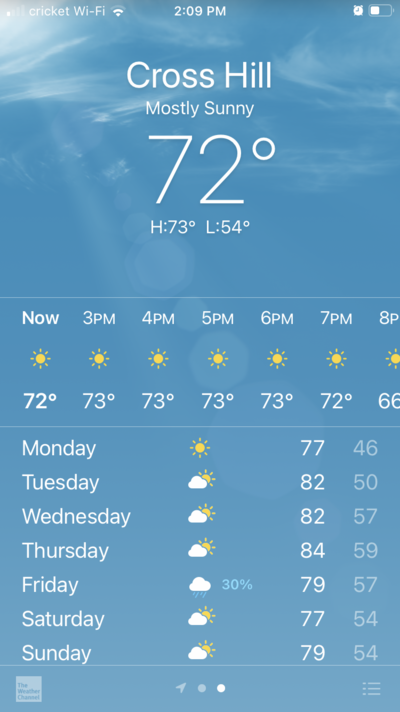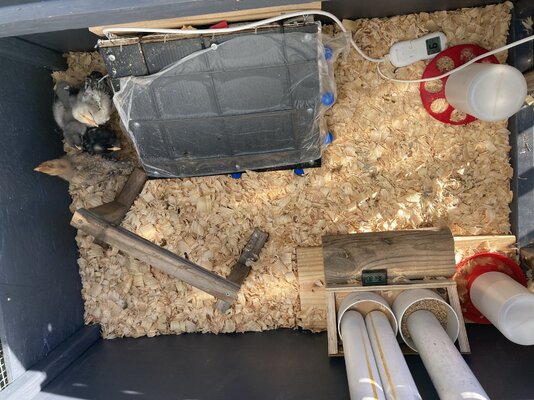I’m looking for some confirmation that I am doing things correctly. I built an outdoor brooder for our 2 week old chicks. I have a mamma heating pad in there set up like a lean to, that they can go under to stay warm. I moved them out there today and would like them to stay out there permanently. Our low temps will be In the low 50s. How can I tell if the heating pad is providing them enough warmth?
Navigation
Install the app
How to install the app on iOS
Follow along with the video below to see how to install our site as a web app on your home screen.
Note: This feature may not be available in some browsers.
More options
You are using an out of date browser. It may not display this or other websites correctly.
You should upgrade or use an alternative browser.
You should upgrade or use an alternative browser.
Second guessing use of outdoor brooder
- Thread starter KBNAZ
- Start date
Pics
More options
Who Replied?The principle behind the heading pad system is direct contact heat. That means the chicks need to be able to make contact with the heating pad with their backs. I can't really see if the "lean-to" setup accomplishes this.
A better way is to cut a scrap of steel fencing and bungie the heating pad to the fencing frame. Enclose the entire thing in a pillow case so the chicks can't crawl between the steel fencing frame and the heating pad and suffocate. Bend the frame into a "U" shape, so the chicks will fit comfortably under it.
As the chicks grow, doubling in size every week, I adjust the frame so it's higher to accommodate larger chicks and still allow them to make direct contact with the heating pad. Also, you will be lowering the heat each week as the chicks feather out since they will require less heat with feathers to prevent loss of body heat.
In just one more week, if they haven't already, your chicks will not use the heating pad during the day. By age five weeks, they won't use the heating pad at all unless it's freezing at night. At that point, they will be able to live in a coop.
A better way is to cut a scrap of steel fencing and bungie the heating pad to the fencing frame. Enclose the entire thing in a pillow case so the chicks can't crawl between the steel fencing frame and the heating pad and suffocate. Bend the frame into a "U" shape, so the chicks will fit comfortably under it.
As the chicks grow, doubling in size every week, I adjust the frame so it's higher to accommodate larger chicks and still allow them to make direct contact with the heating pad. Also, you will be lowering the heat each week as the chicks feather out since they will require less heat with feathers to prevent loss of body heat.
In just one more week, if they haven't already, your chicks will not use the heating pad during the day. By age five weeks, they won't use the heating pad at all unless it's freezing at night. At that point, they will be able to live in a coop.
The chicks can easily handle your temperatures as long as they have a draft free place to sleep, and can adequately warm themselves up with the heating pad. It really should be more horizontal rather than upright though, to maximize the amount of surface area they have available to warm themselves on.
As far as "how do you know it's providing enough warmth" - when the chicks are pressed against/under the heat source, are they quiet, maybe murmuring a little? No sounds of distress? When you put your hand on the pad, can you easily tell it's warm? No drafts at the heating pad location? If the chicks aren't crying out, and the pad area is warm without drafts, then it should work out fine.
As far as "how do you know it's providing enough warmth" - when the chicks are pressed against/under the heat source, are they quiet, maybe murmuring a little? No sounds of distress? When you put your hand on the pad, can you easily tell it's warm? No drafts at the heating pad location? If the chicks aren't crying out, and the pad area is warm without drafts, then it should work out fine.
- Thread starter
- #4
Thanks. I had it leaning like this in the indoor brooder and they were able to scoot as far back as they wanted to nestle in, but I can change it to the arch shape too.The principle behind the heading pad system is direct contact heat. That means the chicks need to be able to make contact with the heating pad with their backs. I can't really see if the "lean-to" setup accomplishes this.
A better way is to cut a scrap of steel fencing and bungie the heating pad to the fencing frame. Enclose the entire thing in a pillow case so the chicks can't crawl between the steel fencing frame and the heating pad and suffocate. Bend the frame into a "U" shape, so the chicks will fit comfortably under it.
As the chicks grow, doubling in size every week, I adjust the frame so it's higher to accommodate larger chicks and still allow them to make direct contact with the heating pad. Also, you will be lowering the heat each week as the chicks feather out since they will require less heat with feathers to prevent loss of body heat.
In just one more week, if they haven't already, your chicks will not use the heating pad during the day. By age five weeks, they won't use the heating pad at all unless it's freezing at night. At that point, they will be able to live in a coop.
Thank you. I will adjust the heating pad. I kept them inside last night. They are choosing to roost on the edge of the heating pad rather than sleep under it. I’ll give the outside brooder a try tonight.The chicks can easily handle your temperatures as long as they have a draft free place to sleep, and can adequately warm themselves up with the heating pad. It really should be more horizontal rather than upright though, to maximize the amount of surface area they have available to warm themselves on.
As far as "how do you know it's providing enough warmth" - when the chicks are pressed against/under the heat source, are they quiet, maybe murmuring a little? No sounds of distress? When you put your hand on the pad, can you easily tell it's warm? No drafts at the heating pad location? If the chicks aren't crying out, and the pad area is warm without drafts, then it should work out fine.
I brood outdoors on day 1. A secure and draft free brooder and a heat source are all you need.
I use one of those cheap TSC prefab type coops as my brooder. Works very well and you can keep it next to the real coop so they get raised as part of the flock.
I use one of those cheap TSC prefab type coops as my brooder. Works very well and you can keep it next to the real coop so they get raised as part of the flock.
Raindawg
Chirping
I got my 5 chicks on March 27th and immediately put them into an outdoor brooder with an Brinsea Ecoglow brooder plate. Because our lows were still down into the low 30's I also installed a heat lamp. The in coop thermometer was often around 40° in the morning but all 5 chicks were under the brooder plate. Now 5 weeks later they are all almost fully feathered and spent an hour outside in the run today (57°). As long as they have access to a heat source they will find it. They are a little tougher (and smarter!) than most people give them credit for.
Similar threads
New posts New threads Active threads
-
Latest threads
-
-
-
-
-
When and how to add new pullets with existing pullets?
- Started by ViolentInsides
- Replies: 1
-
-
Threads with more replies in the last 15 days
-
-
-
-
Please Help! Eggbound & Possible Prolapsed Vent
- Started by Elspeth Dinsmore
- Replies: 97
-
2 week old chick labored breathing, gasping, lethargy
- Started by RandomAnarchy
- Replies: 87
-





